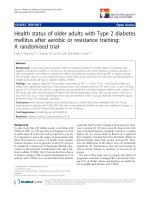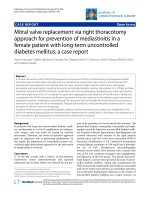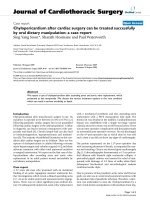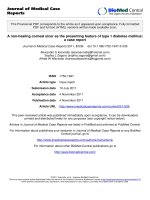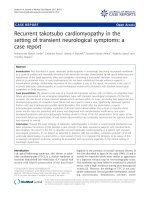Transient Neonatal Diabetes Mellitus followed by recurrent asymptomatic hypoglycaemia: a case report
Bạn đang xem bản rút gọn của tài liệu. Xem và tải ngay bản đầy đủ của tài liệu tại đây (406.94 KB, 4 trang )
Priyadarshi et al. BMC Pediatrics (2015) 15:200
DOI 10.1186/s12887-015-0512-7
CASE REPORT
Open Access
Transient Neonatal Diabetes Mellitus
followed by recurrent asymptomatic
hypoglycaemia: a case report
Archana Priyadarshi1†, Charles F. Verge2,3†, Leah Vandervliet2†, Deborah JG Mackay4† and Srinivas Bolisetty1,3*
Abstract
Background: Transient Neonatal Diabetes Mellitus is the commonest cause of diabetes presenting in the first week
of life. Majority of infants recover by 3 months of age but are predisposed to developing type 2 diabetes later on in
life. This condition is usually due to genetic aberrations at the 6q24 gene locus, and can be sporadic or inherited.
This disorder has three phases: neonatal diabetes, apparent remission, relapse of diabetes.
Case Presentation: Our case, a neonate presented with low birth weight and growth retardation along with the
metabolic profile consistent with transient diabetes mellitus at birth. We report a novel clinical observation of
recurrent asymptomatic hypoglycaemia detected on pre-feed blood glucose level monitoring in our case with
transient neonatal diabetes mellitus at 6 weeks of age, 4 weeks after the remission of diabetes mellitus.
Conclusion: This case demonstrates that neonates in remission following transient diabetes mellitus can present with
recurrent asymptomatic hypoglycaemia without any other obvious congenital malformations seen. This asymptomatic
hypoglycaemia may persist for weeks and may be missed if pre-feed blood glucose level monitoring is not done in
these infants. Also, these infants may require an aggressive enteral feeding regimen with high glucose delivery rate to
maintain normoglycemia.
Keywords: Transient Neonatal Diabetes Mellitus, 6q24 gene defect, Hypoglycaemia
Background
Transient Neonatal Diabetes Mellitus (TNDM) is a rare
genetic form of diabetes with incidence between
1:400,000 and 1:500,000 [1]. TNDM presents in the neonatal period requiring insulin treatment, remits by
18 months of age (median 3 months) and may relapse in
later childhood or adolesence [2, 3]. This condition can
be sporadic or inherited, with 70 % of the cases due to
defects at TNDM locus on chromosome 6q24 [1, 2].
We report a case of TNDM due to a de novo 6q24
duplication arising on paternally derived chromosome
who developed recurrent asymptomatic hypoglycaemia
during the remission phase.
* Correspondence:
†
Equal contributors
1
Royal Hospital for Women, Randwick, Sydney, Australia
3
School of Women’s and Children’s Health, University of New South Wales,
Sydney, Australia
Full list of author information is available at the end of the article
Case presentation
Our case was a male infant, conceived by in-vitro fertilisation with donor sperm, born at 37 weeks gestation
with a birth weight of 2125 gms(5th percentile), length
44.5cms (5th percentile) and head circumference
30.5cms (1st percentile). He was delivered via caesarean
section due to intrauterine growth restriction (IUGR)
suspected in the last trimester of pregnancy. There was
no maternal history of gestational diabetes or hypertension and maternal infection serology was negative. The
infant was noted to have mild pitting oedema of lower
limbs, extending up to the umbilicus, which spontaneously resolved by day 3 of life. He also had mild macroglossia. There was no family history of diabetes apart
from the history that his maternal grandmother developed Type 2 Diabetes in her 80s.
Formula feeds (upon parental request) were commenced soon after birth at 60 ml/kg/day and were given
as third hourly bolus feeds. At 10 h of age, the infant
was detected to have hyperglycaemia with blood glucose
© 2015 Priyadarshi et al. Open Access This article is distributed under the terms of the Creative Commons Attribution 4.0
International License ( which permits unrestricted use, distribution, and
reproduction in any medium, provided you give appropriate credit to the original author(s) and the source, provide a link to
the Creative Commons license, and indicate if changes were made. The Creative Commons Public Domain Dedication waiver
( applies to the data made available in this article, unless otherwise stated.
Priyadarshi et al. BMC Pediatrics (2015) 15:200
level (BGL) of 18 mmol/L on routine pre-feed monitoring performed for intrauterine growth restriction, as per
unit policy. Subsequent pre-feed BGL remained consistently high (8.0–15.6 mmol/L) over the next 12 h with
glycosuria but no ketonuria. This was managed with
diluted formula feeds (¼ strength) given as hourly bolus
feeds, with rapid resolution of hyperglycaemia and no
insulin treatment was required. On day 3 of life full
strength formula feeds were re-introduced gradually
increasing to 150 ml/kg/day as 3rd hourly sucking feeds.
However, on day 7 of life, there was a relapse of hyperglycaemia (BGL 19 mmol/L) associated with poor feeding, weight loss of 14.8 % since birth, and non-bilious
vomiting. This was managed with intravenous insulin
infusion 0.02 U/kg/hr with continous tube feeds of
standard term infant formula (20 kcal/30 mL). Insulin
levels measured at the time of hyperglycemia (BGL
11.3 mmol/L) and before insulin treatment were undetectable (<2 mU/L), with low C peptide level of
0.1 nmol/L, beta-hydroxybutyrate 0.09 mmol/L and free
fatty acids 0.11 mmol/L. His Thyroid function tests were
normal. Blood Autoantibody testing against insulin,
Tyrosine phosphatase-related islet antigen 2 (IA2) and
glutamic acid decarboxylase (GAD) were all negative.
Ultrasound revealed structurally normal pancreas and
kidneys. On day 11 of life, normal term infant formula
was changed to fully hydrolysed amino acid formula
(Neocate-LCP, Nutricia) due to blood in stools, clinically
consistent with cow’s milk protein colitis. There was a
clinical response detected to this change with no further
blood in stools.
From day 12 of life, the insulin infusion was gradually weaned and ceased by day 19 with stable BGLs
of 4–6 mmol/L. Third hourly formula feeds (20 kcal/
30 mL) via gastric tube were again established with
regular BGL monitoring.
On day 44 of life, hypoglycemia (BGL 2.1 mmol/L)
was detected on routine capillary pre-feed sugar monitoring. The infant at that point was on 170 ml/kg/day of
3rd hourly formula tube feeds with an estimated glucose
delivery rate (GDR) of 8.5 mg/kg/min and energy density
of 20 kcal/30 mL. Further pre-feed glucose monitoring
revealed recurrent asymptomatic hypoglycaemic episodes (BGL ranging 2.0–2.5 mmol/L). Critical blood
sample collected at the time of hypoglycaemia (BGL
2.4 mmol/L) showed no evidence of hyperinsulinism, an
appropriately suppressed insulin level (<2 mU/L), and
detectable beta-hydroxybutyrate (0.19 mmol/L) levels.
There was no response to Glucagon injection when tried
to treat a random episode of hypoglycaemia (BGL
2 mmol/L), but resolved after increasing the energy
density in the formula suggesting substrate deficiency as
the cause. Of note, the baby’s weight standard deviation
score had decreased from −2.17 at birth to −2.66. The
Page 2 of 4
energy density of the formula 20 kcal/30 mL was increased by adding glucose polymer (Polyjoule, Nutricia)
(2 kcal/30 mL) to fortify it to 22 kcal/30 mL. This increased the glucose content of the milk to 8.7 % to give
GDR of 10.3 mg/kg/min with 128 kcal/kg/day. The formula was then concentrated to 22 kcal/30 ml to make the
total energy density 24 kcal/30 ml. This increased the glucose content to 9.6 % to give GDR to 11 mg/kg/min at
165 ml/kg/day with 130 kcal/kg and was required to
maintain normoglycemia. The formula was concentrated
to maintain the protein to energy ratio to allow adequate
energy for growth secondary to IUGR. The increased fat
and protein intake by concentrating the formula was
intended to reduce the glycemic load rather than just add
extra glucose. The carbohydrate in the Neocate-LCP is
dried glucose syrup that has a high glycemic index.
The infant was discharged home on third hourly nasogastric tube feeds at 24 kcal/30 mL, at 170 ml/kg/day.
Two oral feeds per day were allowed under the guidance
of a speech pathologist. Parents were trained to perform
pre-feed BGL at home and were educated to treat
emergency hypoglycaemia at home with a glucose
polymer solution (33 % concentration) to provide one
hour’s worth of glucose administered as a bolus via
nasogastric tube.
At 14 months of age, there was no further
hypoglycaemia and his weight standard deviation score
had improved to −0.32. The infant underwent a monitored fasting study for 12 h. At the end of the 12-h fast
the BGL remained normal (3.3 mmol/L), with appropriately elevated beta-hydroxybutyrate (1.49 mmol/L) and
free fatty acids (0.73 mmol/L). The following day the
baby developed adenovirus gastroenteritis and was
readmitted to hospital with hypoglycaemia, indicating
a tendency to ketotic hypoglycaemia during intercurrent illness.
Genetic DNA testing for neonatal diabetes revealed no
pathogenic mutation in common KCNJ11, ABCC8 and
INS genes. Mutations in these genes is the most common cause of permanent neonatal diabetes [1]. Methylation specific PCR of the infant’s DNA and microsatellite
analysis on the infant and mother’s DNA at several
markers within the TNDM critical region were performed.
This revealed presence of partial hypo-methylation at the
TNDM locus and increased paternal allele dosage in the
patient, suggestive of paternal duplication of 6q24 locus.
Subsequent analysis of paternal blood-derived DNA
showed no evidence of duplication, suggesting that this
duplication probably arose de-novo.
Case discussion
Our infant presented with low birth weight and growth
retardation along with the metabolic profile consistent
with transient diabetes mellitus. The growth retardation
Priyadarshi et al. BMC Pediatrics (2015) 15:200
is consistent with the finding with those with abnormality of the 6q24 gene locus for TNDM [1, 4] and is likely
related to the failure of insulin secretion, which is a
potent growth factor in fetal life [1].
Our infant, growth restricted at birth developed asymptomatic hypoglycaemia at 6 weeks of age with no evidence
of hyperinsulism. His declining weight Standard deviation
score and response to increased feed intake suggests substrate deficiency as the cause of his hypoglycaemic episodes. These hypoglycaemic episodes did not respond to
glucagon treatment and diazoxide therapy was not tried as
there was no evidence of hyperinsulism.
Asymptomatic hypoglycaemia as noted in our case is a
very rare observation in this rare syndrome. We compare
our case with the previous 6 cases reported by Flanagan
et al. [4]. Flanagan’s report quoted 14 % incidence of
hypoglycaemia in their cohort (6 out of 43 cases), all of
which were symptomatic. The mean age of onset of symptomatic hypoglycaemia in their cases was 29 weeks. Five
of their 6 cases had TNDM due to paternal uniparental
disomy; of these 3 had hyperinsulinism (detectable insulin
levels at the time of hypoglycaemia) and 2 had probable
hyperinsulinism (undetectable insulin levels, but suppressed ketones at the time of hypoglycaemia, and
zresponse to diazoxide therapy. The remaining case had a
paternal duplication similar to our patient, but neither
insulin nor ketones were measured at the time of
hypoglycaemia. This case also had only short-lived episodes of hypoglycaemia with intercurrent illness (similar
to our patient) whereas the other 5 had ongoing problems
for 2 or more years (4 requiring diazoxide therapy and the
other requiring continuous overnight feeds).
The genetic cause of transient neonatal diabetes mellitus has been attributed to overexpression of imprinted
and paternally expressed gene/s within the TNDM critical region at 6q24 chromosome [4]. Two imprinted
genes, ZAC(zinc finger protein associated with apoptosis
and cell cycle arrest) and HYMAI (imprinted in hydatidiform mole) have been identified as potential candidates
[1]. Three genetic mechanisms have been shown to
result in TNDM: paternal uniparental isodisomy of
chromosome 6, paternally inherited duplication of 6q24,
and a methylation defect at a CpG island overlapping
exon 1of PLAGL1/HYMAI [4]. Our case was detected to
have a partial hypomethylation at the TNDM locus of
6q24 and also had additional paternal allele dosage
detected on the 6q24 gene. Thus, in view of the absence
of a significant methylation defect, the abnormality in
our patient was attributed to the duplication of paternal
6q24 gene, resulting in TNDM.
With regards to timing of BGL monitoring, hypoglycemia
in our infant was detected on pre-feed sugar monitoring
while on 170 ml/kg/day of 3rd hourly enteral feeds. Postfeed BGL following these hypoglycaemic episodes were
Page 3 of 4
always normal. Pre-feed detection of low BGL resulted in
early detection of hypoglycemia. There is no study that
looks specifically at the optimal timing and intervals for
glucose screening. Our case demonstrates that the brief
period of asymptomatic recurrent hypoglycaemia would
have been likely missed, if only post feed BGLs were
monitored.
Animal model studies have shown an increase in the
number of pancreatic beta cells prior to diabetes remission and it is possible that in some patients there is an
‘overshoot’ of this process and consequently beta cell
hyperplasia [5], however our patient had undetectable
insulin during the episode of hypoglycemia.
Conclusion
Thus, it is important to be aware of the risk of
hypoglycemia in early days of life following remission of
diabetes mellitus in patients with 6q24 chromosome defect. We suggest regular pre-feed BGL monitoring in
these infants to identify subclinical hypoglycaemia which
may not be noticed on post-feed BGL monitoring alone.
Patient Consent
Written informed consent was obtained from the parent
(mother) of the patient for publication of this case report. A copy of the written consent is available for review by the Editor of this Journal. The present case
report was performed in accordance with the institutional ethics regulations.
Abbreviations
BGL: Blood glucose level; GDR: Glucose delivery rate; IUGR: Intrauterine
growth retardation; TNDM: Transient Neonatal diabetes Mellitus.
Competing interests
The authors declare that they have no competing interests. The authors
have no financial relationships relevant to this article
Authors’ contributions
AP :carried out data collection, drafted the initial manuscript, involved in the
clinical care of the patient, co-ordinated further co-author reviews, critically
reviewed the manuscript. CV:performed the clinical diagnosis, guided patient
clinical management, significant contribution to the discussion of the case,
critically reviewed the manucript. LV: consulted for Dietics advice on the
the clinical management of the case, critically reviewed the data on the
dietic management of the case. DM:performed the molecular analysis of
6q24 gene, confirming the diagnosis of the case, critically reviewed the
manuscript. SB:supervised data collection, mentor to AP, involved in the
clinical care of the patient, critically reviewed the manuscript. All authors
approved the final article as submitted.
Acknowledgments
Authors express their gratitude to the family of the index case for giving
their permission to publish the case report. Dr Deborah JG Mackay is funded
by Diabetes, UK.
Author details
1
Royal Hospital for Women, Randwick, Sydney, Australia. 2Sydney Children’s
Hospital, Randwick, Sydney, Australia. 3School of Women’s and Children’s
Health, University of New South Wales, Sydney, Australia. 4Faculty of
Medicine, University of Southampton, Southampton, UK.
Priyadarshi et al. BMC Pediatrics (2015) 15:200
Page 4 of 4
Received: 23 May 2015 Accepted: 24 November 2015
References
1. Temple IK, Shield JP. 6q24 transient neonatal diabetes. Rev Endocr Metab
Disord. 2010;11:199–204.
2. Docherty LE, Kabwama S, Lehmann A, Hawke E, Harrison L, Flanagan SE, et al.
Clinical presentation of 6q24 transient neonatal diabetes mellitus(6q24
TNDM) and genotype-phenotype correlation in an international cohort
of patients. Diabetologia. 2013;56(4):758–62.
3. Temple IK, Gardner RJ, Mackay DJ, Barber JC, Robinson DO, Shield JP.
Transient neonatal diabetes:widening the understanding of the
etiopathogenesis of diabetes. Diabetes. 2000;49(8):1359–66.
4. Flanagan SE, Mackay DJ, Greeley SA, McDoanld TJ, Mericq V, Hassing J, et al.
Hypoglycaemia following diabetes remission in patients with 6q24
methylation defects: expanding the clinical phenotype. Diabetologia. 2013;
56(1):218–21.
5. Ma D, Shield JP, Dean W, Leclerc I, Knauf C, Burcelin R, et al. Impaired
glucose homeostasis in transgenic mice expressing the human transient
neonatal diabetes mellitus locus TNDM. J Clin Invest. 2004;114(3):339–48.
Submit your next manuscript to BioMed Central
and we will help you at every step:
• We accept pre-submission inquiries
• Our selector tool helps you to find the most relevant journal
• We provide round the clock customer support
• Convenient online submission
• Thorough peer review
• Inclusion in PubMed and all major indexing services
• Maximum visibility for your research
Submit your manuscript at
www.biomedcentral.com/submit


